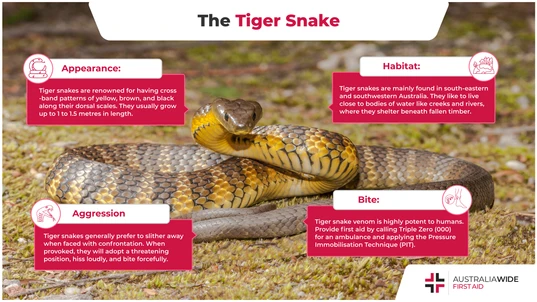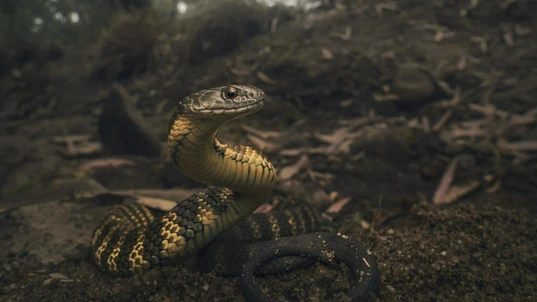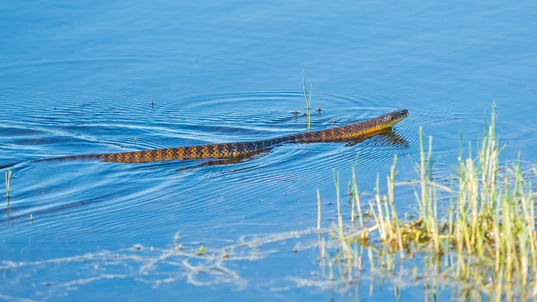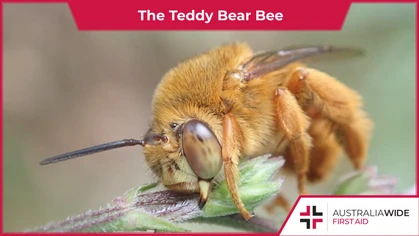Snake Facts: The Tiger Snake

Bites and Stings

Tiger snakes are so named because of distinctive tiger-like stripes along their dorsal scales. They are particularly prevalent near bodies of water during the summer, and their venom is highly neurotoxic and can kill.
Isn’t it wonderful that summer is just around the corner? Besides us, guess who else loves summer, the warm vibes and swimming? Snakes! Not just any snake, but the Tiger snake. Snakes in general become more active during the warmer months. Tiger snakes especially enjoy being in water. They are swimming around the same rivers and lagoons that people normally go to for a fun time. It is important to be wary of tiger snakes as they are dangerous to humans due to their toxic and lethal venom. In this article, we’ll cover all the important points that you need to know about Tiger snakes; where they are found in Australia, their habits, whether they’re a danger to us, what you’ll need to do in case you’re ever bitten by one and some fun facts. Let’s go!
A wild tiger snake in its natural habitat, on a riverbank in Melbourne, Australia.
Identification
As their name suggests, Tiger snakes are well known for their distinctive Tiger-like stripes. They usually grow up to about 1 to 1.5 metres long, and their wider head is slightly recognisable from their neck. Though Tiger snakes are typically identified by cross-band patterns of yellow, brown, and black, some do not have stripes on their scales. However, the disruptive colouration contrasts from pale to dark patterns. Their underbelly is usually unbanded or lighter than their dorsal scales, and while the Tiger snakes from Tasmania are mostly jet black in colour, the Peninsula tiger snake, which can be found on the peninsulas and islands off South Australia, are light coloured. Their fangs usually grow from 3.5 to 5 millimetres in length, and you can differentiate the males from the females by looking at their body sizes and tails – males tend to have a larger head, greater body size, and thicker tails.Habitat
Tiger snakes are found mainly in south-eastern Australia and southwestern Australia, including south-eastern Queensland, southern and eastern New South Wales, most parts of Victoria, the Bass Strait islands and Tasmania. In Melbourne, they are found mostly in the western suburbs. In Queensland, these snakes are found in isolated locations, for instance, the Carnarvon Ranges, Cooloola and the Bunya Mountains. Tiger snakes are typically found in locations that have plenty of hiding covers and are close to bodies of water, including creeks, rivers, lakes, dams, lagoons, wetlands and swamps. They typically seek shelter in fallen timber, deep vegetation and empty burrows. Tiger snakes are also excellent climbers and have been found 10 metres above the ground in both natural vegetation and urban environments.
A venomous tiger snake hunting for food in the Herdsman Lake in Perth, Western Australia.
Habit
Tiger snakes have a preferred hunting period. They usually hunt for food during broad daylight or warm evenings. They can hold their breath and stay underwater for up to 10 minutes while searching for aquatic organisms like frogs and fishes. They have climbing capabilities by contracting their lower muscles into a S formation (concertina locomotion) and pushing their body upwards to eat bats, birds and squirrels. Tiger snakes are ophiophagus and will kill their own and other species of snakes. Ophiophagus refers to a type of involuntary combat wherein once the snake’s biting reflex starts, it begins to feast unless disturbed. The sun's warmth along with the dangerous toxicity of venom speeds up food digestion by breaking down the whole prey inside.Danger
Tiger snakes are shy in nature and do not prefer confrontation when faced with a threat. They prefer to slither away to safety. If a Tiger snake is cornered, it will put on a threatening display by lifting its body off the ground in a tense position with its head raised and its eyes focused on the intruder. It will then hiss loudly as a warning and inflate its neck and head to intimidate. If it is further provoked or feels threatened, it will strike and bite forcefully. The venom of a Tiger snake is highly potent as it contains neurotoxins, coagulants, and mycotoxins. Tiger snakes account for an estimated 17% of snakebites in Australia with four deaths recorded. Tiger snakes are highly venomous and are dangerous to humans.First Aid
If you are bitten by a Tiger snake, it is crucial to act as soon as possible to stop the venom from circulating through the body. Call Triple Zero (000) for an ambulance and perform the following first aid steps:- Keep the casualty at rest and as still as possible to stop the venom from travelling through the body.
- Constantly observe and reassure the casualty.
- Follow DRSABCD and be prepared to perform CPR
- Apply the ‘pressure immobilisation technique’ (PIT):
If the bite site is on a limb, cover it with a wide heavy elastic bandage (10 - 15 cm wide).
Ensure the bandage is firm and tight, so tight you cannot easily slide a finger between the bandage and the skin.
Apply a second heavy elastic bandage. Start from the fingers or toes and wind up the limb as far as possible. Consistent coverage (overlapping half over half) and consistent pressure (firm but not cutting off circulation) are key to an effective PIT. - On the bandage, mark the spot where the bite occurred with a pen or felt-tip marker.
- Immobilise the limb and joints with a splint, or use a sling if the bite site is on an arm. Keep the limb immobilised until the ambulance arrives.
Anaphylaxis
Some people can have a severe allergic reaction when bitten by a Tiger snake. This is called anaphylaxis, a condition that can be fatal in as little as 15 minutes. Symptoms include:- Tightness of the throat from swelling.
- Difficulty breathing.
- Tongue and facial swelling.
- Hoarse voice or difficulty speaking.
- A wheeze or persistent cough.
- Collapse or falling unconscious.
- Becoming pale or floppy (young children).
- Abdominal pain and vomiting.
- Hives, welts, and body redness.
Fun Facts
- Tiger snakes are most commonly found in Australia. Their population is stable and is labelled “Least Concern” by the International Union for Conservation of Nature (IUCN).
- Tiger snakes are solitary and only interact with other Tiger snakes during mating.
- They have a lifespan of about 10 years but can live up to 15 years.
- Predators of Tiger snakes are birds of prey, ibises and kookaburras. Research has found that many Tiger snakes are blind in one or both eyes due to attacks by seagulls.
- Tiger snakes also suffer from parasites, tape worms, roundworms, tongue worms and flukes.
Final Thoughts
To learn how to provide first aid for a Tiger snake bite, including how to apply a pressure immobilisation bandage and splint, book a date to learn First Aid with Australia Wide First Aid today!Looking to get you First Aid knowledge up to date?
We run certified First Aid courses throughout all major Acustralian citys. Find a location near you.
Originally published at
https://www.australiawidefirstaid.com.au/resources/tiger-snake
as part of the Australia Wide First Aid Articles Library









